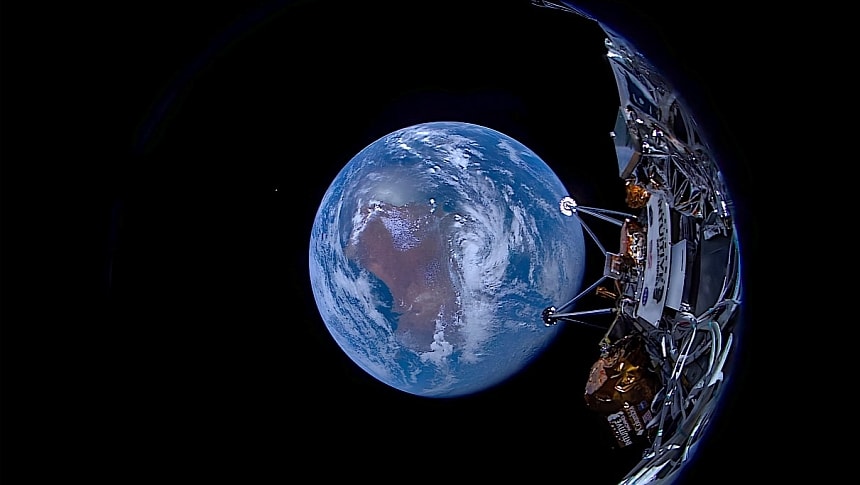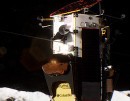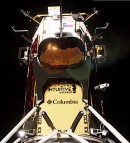It was on December 7, 1972 when the Apollo 17 mission landed on the Moon. It was to be America's last crewed mission to Earth's natural satellite, but it also happens to have become the country's final mission of any kind to the place. Until this week, that is.
After a pause of more than 50 years, during which time it focused more on Mars and other places in our solar system, the U.S. has finally landed something on the Moon. A collaborative effort between NASA and a private space company called Intuitive Machines, the Nova-C-class lander called Odysseus successfully touched down on the barren surface of the rock.
The IM-1 mission, as it's called, lifted off from Launch Complex 39A at the Kennedy Space Center in Florida on February 15. It was powered by a SpaceX Falcon 9 rocket.
The mission is the second of NASA's Commercial Lunar Payload Services (CLPS) program, an effort meant to enlist the help of private companies in advancing the goals of the Artemis Moon exploration push. The first one, the Peregrine lander made by a company named Astrobotic, failed earlier in January.
As per the details provided by the space agency, the Odysseus touched down on the surface of Luna at 5:23 PM CST on Thursday, February 22. The operation was not without problems, as a number of technical issues that ultimately proved irrelevant caused a delay in the initial landing schedule.
Odysseus' arrival on the Moon not only marks America's return there in more than a century, but it will also enter the history books as the moment when the nation managed its first commercial Moon soft landing.
The Intuitive Machine carries with it a total of 12 science experiments, six from NASA and the rest from private partners. One of the space agency's most important onboard cargo is the Lunar Node-1 navigational experiment, which will be used to test whether a land-based navigation network could be established on the surface.
The private experiments, on the other side, range from artwork sent up there by Jeff Koons to thermal reflective insulation.
Perhaps the most interesting of all these private experiments is the camera system called EagleCam, which was used to snap the "world's first-ever third-person picture of a spacecraft making an extraterrestrial landing." We're still waiting to see if it succeeded so we can enjoy the view.
As for the lander itself, we're talking about a piece of hardware that is 14 feet (4.3 meters) high and weighs 1,488 pounds (675 kg). It can carry at most 286 pounds (130 kg) of science with it.
The estimated duration of the IM-1 mission to the Moon is just seven days, because after that the long lunar night will descend over the Malapert A, where the thing touched down, and chances are it will render Odysseus and its cargo inoperable.
The IM-1 mission, as it's called, lifted off from Launch Complex 39A at the Kennedy Space Center in Florida on February 15. It was powered by a SpaceX Falcon 9 rocket.
The mission is the second of NASA's Commercial Lunar Payload Services (CLPS) program, an effort meant to enlist the help of private companies in advancing the goals of the Artemis Moon exploration push. The first one, the Peregrine lander made by a company named Astrobotic, failed earlier in January.
As per the details provided by the space agency, the Odysseus touched down on the surface of Luna at 5:23 PM CST on Thursday, February 22. The operation was not without problems, as a number of technical issues that ultimately proved irrelevant caused a delay in the initial landing schedule.
Odysseus' arrival on the Moon not only marks America's return there in more than a century, but it will also enter the history books as the moment when the nation managed its first commercial Moon soft landing.
The Intuitive Machine carries with it a total of 12 science experiments, six from NASA and the rest from private partners. One of the space agency's most important onboard cargo is the Lunar Node-1 navigational experiment, which will be used to test whether a land-based navigation network could be established on the surface.
The private experiments, on the other side, range from artwork sent up there by Jeff Koons to thermal reflective insulation.
Perhaps the most interesting of all these private experiments is the camera system called EagleCam, which was used to snap the "world's first-ever third-person picture of a spacecraft making an extraterrestrial landing." We're still waiting to see if it succeeded so we can enjoy the view.
As for the lander itself, we're talking about a piece of hardware that is 14 feet (4.3 meters) high and weighs 1,488 pounds (675 kg). It can carry at most 286 pounds (130 kg) of science with it.
The estimated duration of the IM-1 mission to the Moon is just seven days, because after that the long lunar night will descend over the Malapert A, where the thing touched down, and chances are it will render Odysseus and its cargo inoperable.


















